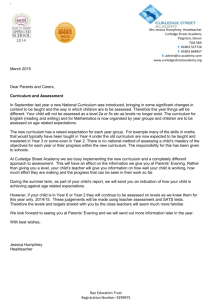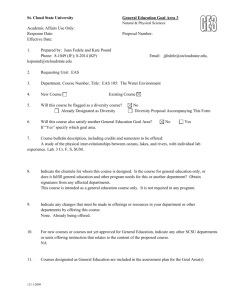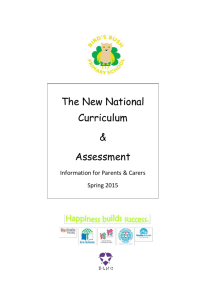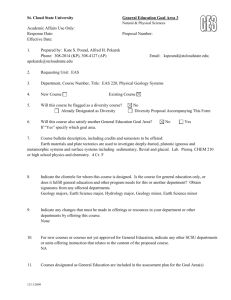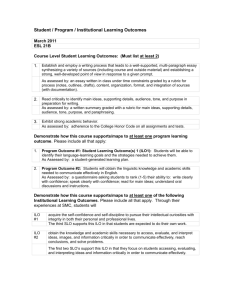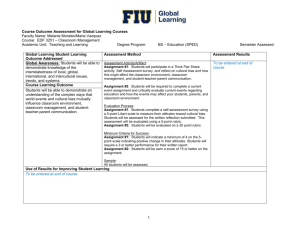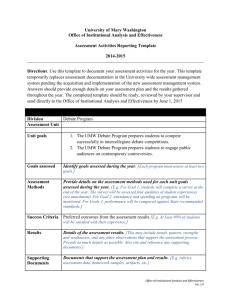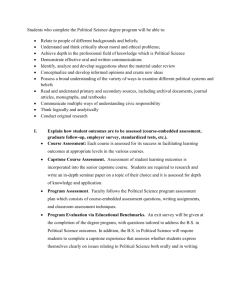St. Cloud State University
advertisement
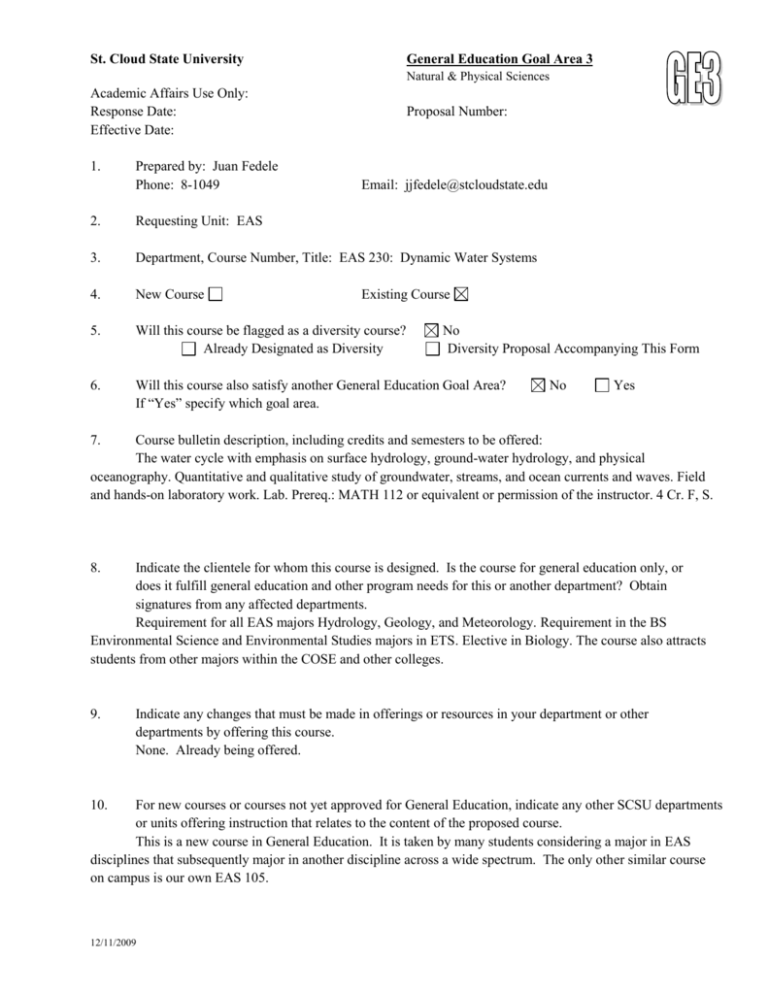
St. Cloud State University General Education Goal Area 3 Natural & Physical Sciences Academic Affairs Use Only: Response Date: Effective Date: 1. Prepared by: Juan Fedele Phone: 8-1049 Proposal Number: Email: jjfedele@stcloudstate.edu 2. Requesting Unit: EAS 3. Department, Course Number, Title: EAS 230: Dynamic Water Systems 4. New Course 5. Will this course be flagged as a diversity course? Already Designated as Diversity 6. Will this course also satisfy another General Education Goal Area? If “Yes” specify which goal area. Existing Course No Diversity Proposal Accompanying This Form No Yes 7. Course bulletin description, including credits and semesters to be offered: The water cycle with emphasis on surface hydrology, ground-water hydrology, and physical oceanography. Quantitative and qualitative study of groundwater, streams, and ocean currents and waves. Field and hands-on laboratory work. Lab. Prereq.: MATH 112 or equivalent or permission of the instructor. 4 Cr. F, S. 8. Indicate the clientele for whom this course is designed. Is the course for general education only, or does it fulfill general education and other program needs for this or another department? Obtain signatures from any affected departments. Requirement for all EAS majors Hydrology, Geology, and Meteorology. Requirement in the BS Environmental Science and Environmental Studies majors in ETS. Elective in Biology. The course also attracts students from other majors within the COSE and other colleges. 9. Indicate any changes that must be made in offerings or resources in your department or other departments by offering this course. None. Already being offered. 10. For new courses or courses not yet approved for General Education, indicate any other SCSU departments or units offering instruction that relates to the content of the proposed course. This is a new course in General Education. It is taken by many students considering a major in EAS disciplines that subsequently major in another discipline across a wide spectrum. The only other similar course on campus is our own EAS 105. 12/11/2009 11. Courses designated as General Education are included in the assessment plan for the Goal Area(s) for which they are approved. Courses for which assessment is not included in the annual GE assessment report for two years will be removed from the General Education Program. The Requesting Unit understands and recognizes the above conditions. 13. Provide a concise explanation of how the following goal is a “significant focus” of the proposed course. Goal Area 3: Natural & Physical Sciences Explore scientific knowledge of the natural world. Understand the central concepts and principles of science; experience the process of scientific inquiry; comprehend science as a human endeavor and understand the impact of science on individuals and on society. This course is divided in 3 modules, each of which covers a topic in the natural sciences: I - Basic Physical Oceanography, II - Basic fluid mechanics, and III -Principles of Surface and Subsurface Hydrology. A separate lab component includes several experiments students perform in a flume, a wave tank, and a stream table. EAS 230 involves the application of physical principles to the analysis of problems involving water and water flows in oceans, rivers, lakes, and underground. 14. In order for a course to be designated as fulfilling Goal Area 3, it must address at least 5 of the 6 student learning outcomes (SLOs) below. Check the SLOs below that are focused on in the proposed general education course. 1. Demonstrate knowledge of concepts, principles, and theories in the physical or natural sciences. 2. Make observations and collect data, design and carry out experiments or other types of scientific investigations. 3. Formulate research questions and testable hypotheses, analyze and interpret data, draw inferences and conclusions, and identify further questions for investigation. 4. Demonstrate awareness of the interdependent relationships of basic science, applied science, mathematics, and technology. 5. Recognize the human nature of the scientific enterprise, including the importance of curiosity, creativity, and imagination; the dual nature of scientific knowledge as changeable and durable; and the impact of a scientist's personal identity on the scientific process. 6. Evaluate societal issues from a science perspective, question the evidence presented, and make informed judgments about these issues. 15. Discuss how each Student Learning Outcome checked above is achieved in this course. (Note: Although descriptions of typical assignments or types of assignments may be part of this discussion, it is not appropriate to submit copies of actual assignments.) SLO1. Demonstrate knowledge of concepts, principles, and theories in the physical or natural sciences. 1- Students will apply algebra and basic principles of physics (such as conservation of mass or mechanical energy) to reason through and solve problems in basic fluid mechanics, river hydraulics, and groundwater flow. Assessed in 3 homework problems, 2 lecture quizzes, and final exam. 2- Students will use algebra and graph analysis to apply the concepts of rate of change of functions (derivative), and area under a curve (graphical integration) to the analysis of velocity profiles (velocity gradients and thus frictional forces) and hydrographs (volumes of water associated with base flows or floods). Assessed in 1 homework, midterm exam, and final exam. 12/11/2009 3- Students will apply water budgets – a basic tool for hydrologists- to specific examples of hydrological systems (watersheds, lakes, aquifers, river reaches). Assessed in homework problem, and 1 lecture quiz. SLO2. Make observations and collect data, design and carry out experiments or other types of scientific investigations. 1- Students will perform laboratory experiments using a laboratory flume, gather data on velocity distributions and flow geometric properties, analyze and present data in plots, and prepare a lab report. Assessed in lab report. 2- Students will design one to two laboratory experiments in which they will measure flow discharge applying velocity profile measurement techniques, and discuss sources or errors and accuracy of measurements, plot data, use graph analysis (graphical integration) and prepare a lab report. Assessed in lab report and midterm exam. 3- Students will perform a laboratory experiment to measure hydraulic conductivity of two different soils (sand and gravel), repeating the classical experiments performed first by Darcy (groundwater flow characteristics and parameters involved). Assessed in lab report and 1 lecture quizz. SLO3. Formulate research questions and testable hypotheses, analyze and interpret data, draw inferences and conclusions, and identify further questions for investigation. 1- Students will test Bernoulli’s principle using measurements. They will perform a laboratory experiment, setting a small dam and a hydraulic jump in a lab flume. They will discuss applicability of the theory and they will develop alternative explanations to adjust theory to observations (i.e. presence of friction and turbulent flow energy dissipation). Assessed in lab report, lecture quiz, and final exam. 2- Students will perform a lab experiment using the wave tank and measure wave properties, including wave celerity, and test their results with theoretical predictions. Assessed in lab report and midterm exam. 3- Students will perform a lab experiment using the stream table, set up waves, and predict and test the coastal line evolution using the theory of longshore currents and drift. Assessed in a lab report and 1 lecture quizz. SLO4. Demonstrate awareness of the interdependent relationships of basic science, applied science, mathematics, and technology. 1- Students will apply basic algebra to solve systems of two equations (continuity and energy conservation) and solve problems such as channel flow over obstacles, canal contractions or expansions, calculatation of river water levels (uniform flow theory), and evaluation of water budgets for a watershed and a lake. They will apply results to water supply analysis and flooding. Assessed in 2 homework problems and final exam. 2- Students will use basic algebra to the design of simple prismatic canals using the uniform flow theory. Assessed in 1 homework. 3- Students will apply basic surface and subsurface (groundwater) hydraulics principles (effects of river roughness, changes in river patterns and slope; aquifer overpumping, saline intrusions) to analyze problems such as flooding, aquifer pollution, and preservation of water resources. Assessed in two to three in-class group or individual exercises. SLO5. Recognize the human nature of the scientific enterprise, including the importance of curiosity, creativity, and imagination; the dual nature of scientific knowledge as changeable and durable; and the impact of a scientist's personal identity on the scientific process. 1- Students will apply the scientific method in lab exercises (velocity profile, discharge, wave measurements) and discuss the applicability of simple theories in predicting physical parameters such as resistance to flow, water stages, or wave height, that are relevant in the solution of engineering problems. Students will also discuss -based on their lab measurements, how these theories can be altered or adjusted to particular situations. Assessed in two homeworks. 12/11/2009 2- Students will use analogies such as simple models of atmospheric circulation or groundwater flow, to visualize how these are used by scientists to understand complex systems and solve practical problems (Darcy’s experiments). Assessed in two homeworks. SLO6. Evaluate societal issues from a science perspective, question the evidence presented, and make informed judgments about these issues. 1- Students will develop awareness on the importance of understanding how physical systems work, and how that knowledge is applied to the solution of practical problems in relation to water resources (lake eutrophication example, coastal relocation example). Assessed in an in-class activity. 2- Students will apply basic physical concepts developed during the class to explain what could or could not be predicted (based on our current scientific knowledge) on problems related to water budgets, river and groundwater flows. Assessed in two in-class activities and 1 lecture quizz 3- Students will explain the impact of human activities on rivers (engineering such as channelization, rectification, re-meandering), aquifers (pumping, overexploitation, contamination), and other ecosystems such as wetlands and lakes (eutrophication , human-induced shore erosion) . Assessed in several in-class individual or group activities. 16. Courses satisfying Goal Area 3: Natural & Physical Sciences must have either a “traditional lab course or a lab-like experience”. Check which of these apply and supply a brief explanation of how the course is either a laboratory course or incorporates a “lab-like experience”. Course includes: Laboratory Lab-like experience The following quote from a National Research Council subcommittee report may help to identify a course with a laboratory. ”Laboratory experiences provide opportunities for students to interact directly with the material world (or with data drawn from the material world), using the tools, data collection techniques, models, and theories of science.” America's Lab Report: Investigations in High School Science (Free Executive Summary) http://www.nap.edu/catalog/11311.html This course has a separate lab component in which students perform laboratory experiments, gather data and write lab reports. Lab experiments include the use of a flume, magnetic flow meter, wave tank, a stream table, and a permeameter. During labs students also devote time solving problems in which they need to apply concepts discussed in lectures, logical reasoning, problem-solving skills, and math. 17. List or attach the Course Outline (adequately described and including percentage of time to be allocated to each topic). Curriculum Committees may request additional information. Topics larger than 20% need to be broken down further. Indicate in your course outline where the Student Learning Outcomes checked above are being met. Assessed SLO # I- Introduction: 10 % Review of some basic mechanics: inertia, forces and motion 1.1 II- Oceanography: 35 % The Coriolis force. Wind circulation. 8% 1.1 Wind-driven ocean circulation; density-driven deep ocean circulation. 8 % 5.2 Related topics: History of the Atlantic; El Niño Southern Oscillation. 5% Waves and beach sediment transport processes. 7% 3.2;5.1 Tides. Coastal hazards; managing the coastal environment 7% 3.3;6.1 III- Fluid Mechanics: 35 % Basic principles. The importance of dimensions and scaling. 4% 1.1 12/11/2009 Laminar and turbulent flows. Continuity and Bernoulli’s equations and applications Friction laws and applications Open-channel flows: Specific Energy and flow regimes Uniform flow calculations and design; natural channels IV- Hydrology: The hydrologic cycle, water budget and its components Surface Hydrology: Hydrograph analysis and component separation Subsurface Hydrology: flow under unsaturated and saturated conditions Basic principles and models for groundwater flow. Water resources: managing our water. 12/11/2009 3% 10 % 6% 7% 5% 1.2;3.1;4.1 2.1;3.1 1.1;2.2;4.1 4.2;6.3 20 % 7% 4% 5% 3% 1% 1.3;4.1;6.2;6.3 1.1;1.3;2.2 2.3;6.2 4.3;5.2 6.3 St. Cloud State University General Education Transmittal Form Academic Affairs Use Only: Response Date: Effective Date: Proposal Number Department: Earth and Atmospheric Sciences Course or Course(s): EAS 105: The Water Environment Department or Unit Chair Signature Date Department forward to Academic Affairs for publication and electronically to Chair of General Education Committee, Chair of College Curriculum Committee, College Dean Recommendation of General Education Committee: Approve Remarks: Disapprove Chairperson Committee Signature Date Recommendation of University Curriculum Committee: Approve Remarks: Disapprove Chairperson Committee Signature Date Recommendation of Faculty Association: Approve Remarks: Disapprove FA Senate Signature Date Action of Academic Vice President: Approve Disapprove Signature Entered in Curriculum Data File 12/11/2009 Remarks: Date
